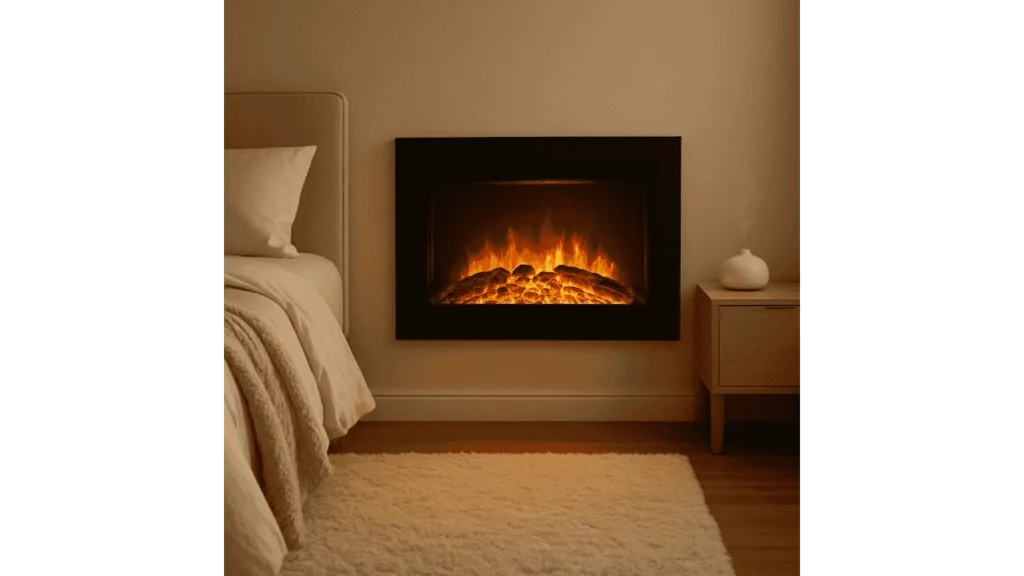Electric fireplaces are generally safer than space heaters because they enclose heating elements, include automatic shut-off systems, and are designed for fixed placement. Unlike space heaters, which are often lightweight, tip-prone, and use exposed heating coils, electric fireplaces reduce fire hazards through thermal sensors, cool exteriors, and visual cues. While both offer supplemental heat, electric fireplaces offer stronger built-in protections, making them the safer choice for long-term use.
Built-in Safety Features
“The number one cause of space heater-related fires is direct contact with combustibles, something electric fireplaces inherently protect against by design,” says Marta Greely, fire prevention engineer at the National Fire Safety Research Council.
Electric fireplaces differ significantly from traditional space heaters in their construction. They do not use exposed heating coils or open flames. Instead, the heating element is safely enclosed behind a cool-to-touch glass panel, significantly lowering the risk of burns or accidental ignition. Many space heaters, on the other hand, leave heating elements exposed, creating a real hazard when placed near furniture, curtains, or children.
Beyond that, most electric fireplaces come with overheat protection and automatic shut-off timers. These internal safety features engage when temperatures climb beyond normal ranges, reducing fire risk. In contrast, while some space heaters include tip-over shut-offs, many lack the advanced thermal sensors that are standard in electric fireplaces.
Structural Stability & Placement
Electric fireplaces are designed to remain stationary. Whether freestanding or wall-mounted, their size and weight prevent easy tipping, a common issue with smaller portable space heaters. Additionally, electric fireplaces typically include visible flame effects and audible fan systems, giving clear visual and audio signals that the unit is operating. This helps users avoid leaving them on accidentally, unlike space heaters, which often operate silently and without warning lights.
Read More: What Does “E3” Mean on an Electric Fireplace?
Accident Statistics & Fire Hazards
According to the U.S. Fire Administration, space heaters cause over 1,600 residential fires annually, leading to hundreds of injuries and deaths. These incidents frequently involve units tipping over or overheating, especially when left unattended. Electric fireplaces, by contrast, are rarely listed in fire incident reports when installed and used correctly. Their design inherently minimizes exposure to fire-starting conditions.
“Data shows that fixed electric heating appliances, such as electric fireplaces, are involved in significantly fewer residential fires compared to portable space heaters,” explains Dr. Terrence Myles, senior safety analyst at Home Heat Systems Review.
Safe Usage Practices for Both Types
Despite their design differences, both electric fireplaces and space heaters must be used responsibly. Always maintain a minimum 3-foot clearance from flammable materials. Units should be plugged directly into a wall outlet, never an extension cord or power strip. It’s also advisable to unplug the unit when not in use, especially before sleeping or leaving the house. This applies particularly to space heaters, which are often used in bedrooms or small, enclosed spaces.
Comfort & User-Friendly Design
Electric fireplaces offer additional value through ambiance. With customizable flame visuals, built-in thermostats, and lower exterior temperatures, they’re a more family- and pet-friendly option. Space heaters may be effective for quick, localized heating, but their simplicity often comes at the cost of user safety. Many lack clear visual cues when turned on and may present a burn risk due to hot surfaces.
Cost vs. Safety Considerations
While electric fireplaces cost more initially, they typically offer better longevity and a safer user experience. Their fixed installation and integrated safeguards make them ideal for long-term use. Space heaters are more affordable upfront but demand higher caution and frequent supervision. Over time, the added safety and usability of an electric fireplace can outweigh its initial cost.
Conclusion
Electric fireplaces are, without question, safer than standard space heaters. Their enclosed design, built-in safety systems, and stable placement significantly reduce fire hazards and accidental injuries. However, no heating device is entirely risk-free. Safe operation, including proper placement, outlet usage, and supervision, remains essential for both options.
- 27 Farmhouse Fireplace Ideas That Bring Warmth & Charm - August 18, 2025
- 25 Fireplace Lighting Ideas to Illuminate Your Hearth - August 7, 2025
- How to Replace an Electric Fireplace Switch? - August 5, 2025



